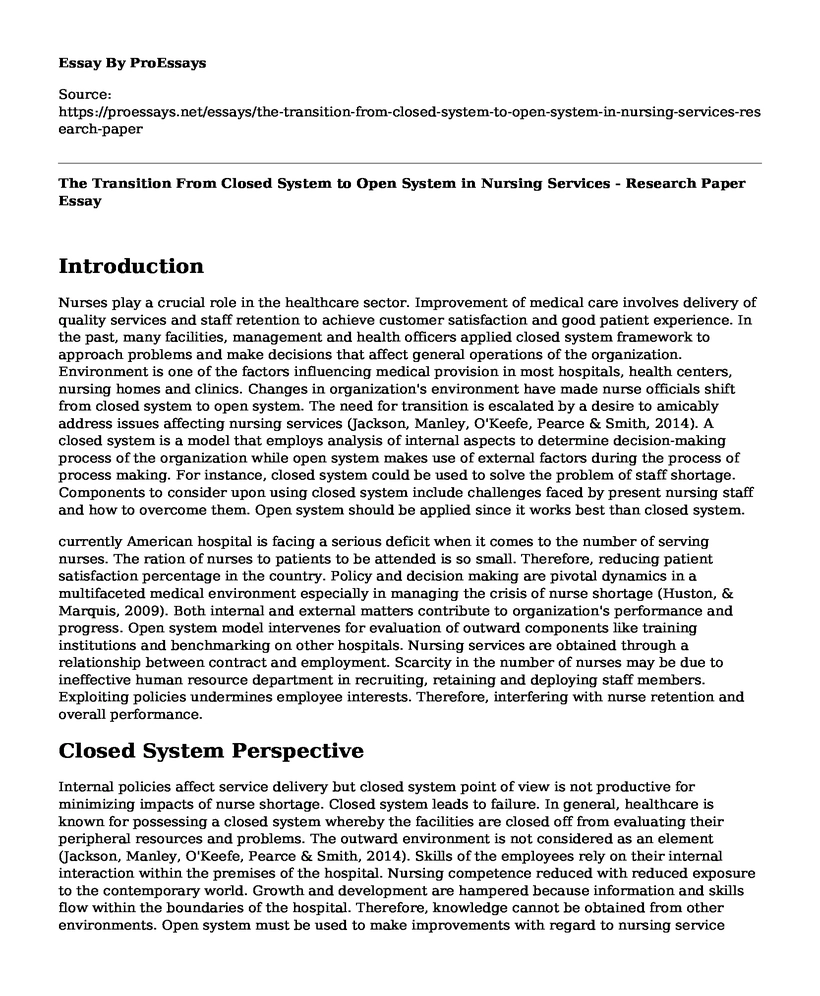Introduction
Nurses play a crucial role in the healthcare sector. Improvement of medical care involves delivery of quality services and staff retention to achieve customer satisfaction and good patient experience. In the past, many facilities, management and health officers applied closed system framework to approach problems and make decisions that affect general operations of the organization. Environment is one of the factors influencing medical provision in most hospitals, health centers, nursing homes and clinics. Changes in organization's environment have made nurse officials shift from closed system to open system. The need for transition is escalated by a desire to amicably address issues affecting nursing services (Jackson, Manley, O'Keefe, Pearce & Smith, 2014). A closed system is a model that employs analysis of internal aspects to determine decision-making process of the organization while open system makes use of external factors during the process of process making. For instance, closed system could be used to solve the problem of staff shortage. Components to consider upon using closed system include challenges faced by present nursing staff and how to overcome them. Open system should be applied since it works best than closed system.
currently American hospital is facing a serious deficit when it comes to the number of serving nurses. The ration of nurses to patients to be attended is so small. Therefore, reducing patient satisfaction percentage in the country. Policy and decision making are pivotal dynamics in a multifaceted medical environment especially in managing the crisis of nurse shortage (Huston, & Marquis, 2009). Both internal and external matters contribute to organization's performance and progress. Open system model intervenes for evaluation of outward components like training institutions and benchmarking on other hospitals. Nursing services are obtained through a relationship between contract and employment. Scarcity in the number of nurses may be due to ineffective human resource department in recruiting, retaining and deploying staff members. Exploiting policies undermines employee interests. Therefore, interfering with nurse retention and overall performance.
Closed System Perspective
Internal policies affect service delivery but closed system point of view is not productive for minimizing impacts of nurse shortage. Closed system leads to failure. In general, healthcare is known for possessing a closed system whereby the facilities are closed off from evaluating their peripheral resources and problems. The outward environment is not considered as an element (Jackson, Manley, O'Keefe, Pearce & Smith, 2014). Skills of the employees rely on their internal interaction within the premises of the hospital. Nursing competence reduced with reduced exposure to the contemporary world. Growth and development are hampered because information and skills flow within the boundaries of the hospital. Therefore, knowledge cannot be obtained from other environments. Open system must be used to make improvements with regard to nursing service delivery and increase the number of nurses.
Open System Perspective
The open system allows exchange of feedback between internal and external jurisdictions. Evaluation of input, goals and output are taken into account during policy formation and decision making. Output and external feedback from a mechanism for determining internal features and systems to adopt (Horowitz, Johnson & Miller, 2008). Support from other hospitals and medical colleges help the facility to create a platform for boosting its scope and viability.
How Open System Improve Healthcare Outcomes
Open system perspective minimizes impacts related to nursing shortage amenity. Teamwork is achieved with the application of this system. Nurses will be able to move from one hospital to another. Human resource circulation improves skills and competence of the staff (Huston & Marquis, 2009). Recruiting procedures are shared with the use of open system method, therefore, retaining the serving nurses.
References
Jackson, C., Manley, K., O'Keefe, H., Pearce, J., & Smith, S. (2014). A Shared Purpose Framework to deliver Person-centered, Safe and Effective Care: Organizational Transformation using Practice Development Methodology. International Practice Development Journal, 4(1).
Huston, C. J., & Marquis, B. L. (2009). Leadership roles and management functions in nursing: Theory and application. Lippincott Williams & Wilkins.
Horowitz, S. D., Johnson, J. K., & Miller, S. H. (2008). Systems-based Practice: Improving the Safety and Quality of Patient Care by Recognizing and Improving the Systems in which We Work. Retrieved from http://www.ahrq.gov/downloads/pub/advances2/vol2/Advances-Johnson_90.pdf
Cite this page
The Transition From Closed System to Open System in Nursing Services - Research Paper. (2022, Dec 09). Retrieved from https://proessays.net/essays/the-transition-from-closed-system-to-open-system-in-nursing-services-research-paper
If you are the original author of this essay and no longer wish to have it published on the ProEssays website, please click below to request its removal:
- Coping With Diabetes Essay
- Nurses Role in the Recovery of Soldiers With PTSD Essay
- Clinical Reflection Paper on Nursing
- Research Paper on Current Reform on Coverage and Payment of the Health Insurance
- A Journey of Pursuing Peace and Education in War-Torn Iraq - Essay Sample
- Essay Example on Covid-19: A Global Crisis Requiring a Change in Behaviour
- The Epic Tales of David & Goliath & The Odyssey - Essay Example







